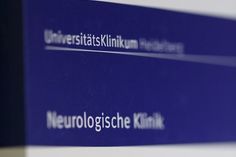Critical Care of Stroke
Overview
Severe ischemic and hemorrhagic strokes are debilitating and lethal diseases and are associated with severe individual and socioeconomic burdens, particularly when patients need mechanical ventilation and admission to a neuro-intensive care unit (Neuro ICU). While past studies have suggested a very bad prognosis and poor outcome in most of these patients, more recent evidence clearly demonstrates the potential of dedicated, individualized and at times aggressive care to improve these patients´ mortality and morbidity. The decisive steps in the multimodal Neuro ICU treatment, however, are still not well understood.
Our study group is dedicated to the analysis and better understanding of critical care aspects of cerebrovascular disease. The aim is to improve the management of patients with severe ischemic and hemorrhagic stroke (large vessel occlusion ischemic stroke, intracerebral hemorrhage, subarachnoid hemorrhage) in the acute and critical care setting. Our research is entirely clinical and has a strong relationship to real-life clinical situations. A strong emphasis of our studies is about the optimal peri-interventional management after severe vascular brain damage. This affects treatment aspects as diverse as optimal airway and ventilation setting, sedation during interventions, blood pressure management and the Neuro ICU stay.
Our studies aim to optimize the peri-interventional management with focus on the optimal sedation and airway management SIESTA (Schönenberger Int J Stroke 2015, Schönenberger JAMA 2016, Schönenberger JAMA 2019) and blood pressure management INDIVIDUATE (Chen Eur Stroke J 2021; Chen Stroke 2023) during endovascular treatment of large vessel occlusion stroke (e.g. general anesthesia with intubation vs conscious sedation without intubation, standardized vs. individualized blood pressure target goals) and during long-term intensive care unit ventilation (e.g. early tracheostomy, SETPOINT (Bösel Int J Stroke 2012; Bösel Stroke 2013), SETPOINT2 (Schönenberger Int J Stroke 2016; Bösel JAMA 2022), SETscore (Schönenberger Neurocrit Care 2015)).
Our group has strong collaborative ties with national (Deutsche Gesellschaft für Neuro-Intensiv- und Notfallmedizin DGNI and its research network IGNITE, Deutsche Vereinigung für Interdisziplinäre Intensiv- und Notfallmedizin DIVI) and international (Neurocritical Care Society, NCS) societies and study groups. Over the last years, our group has participated successfully and been awarded in multicenter NICU stroke studies such as DESTINYII, DEPTH-SOS, CLEAR-IVH III, INCH, and ATACH II.
In addition to monocentric and mechanistic studies we led a collaborative German-US randomized controlled trial - SETPOINT2 - comparing early with late tracheostomy in ventilated stroke patients (Schönenberger Int J Stroke 2016; Bösel JAMA 2022).
Future work will focus on the one hand on intensifying prospective multicenter and network research in critical care of stroke with emphasis on noninvasive neuromonitoring, airway and ventilation management of Neuro ICU stroke patients. One continual major research topic will be peri-interventional management of stroke thrombectomy and our goal is to initiate new studies to elucidate ways to further optimize patient care before, during and after stroke thrombectomy.
SELECTED PUBLICATIONS
Chen M, Meis J, Potreck A, Sauer LD, Kieser M, Bendszus M, Wick W, Ringleb PA, Möhlenbruch MA, Schönenberger S. Effect of Individualized Versus Standardized Blood Pressure Management During Endovascular Stroke Treatment on Clinical Outcome: A Randomized Clinical Trial. Stroke. 2023 Nov;54(11):2755-2765. doi: 10.1161/STROKEAHA.123.044062. Epub 2023 Sep 21.
Bösel J, Niesen, W-D, Salih F, Morris NA, Ragland JT, Gough B, Schneider H, Neumann JO, Hwang DY, Kantamneni P, James ML, Freeman WD, Rajajee V, Venkatasubba Rao C, Nair D, Benner L, Meis J, Klose C, Kieser M, Suarez JI, Schönenberger S, Seder DB; SETPOINT2 and the IGNITE Study Groups. Effect of Early vs Standard Approach to Tracheostomy on Functional Outcome at 6 Months Among Patients With Severe Stroke Receiving Mechanical Ventilation: The SETPOINT2 Randomized Clinical Trial. JAMA. 2022 May 17;327(19):1899-1909. doi: 10.1001/jama.2022.4798.
Schönenberger S, Löwhagen Hendén P, Simonsen CZ, Uhlmann L, Klose C, Pfaff JAR, Yoo AJ, Sørensen LH, Ringleb PA, Wick W, Kieser M, Möhlenbruch MA, Rasmussen M, Rentzos A, Bösel J. Association of General Anesthesia vs Procedural Sedation With Functional Outcome Among Patients With Acute Ischemic Stroke Undergoing Thrombectomy: A Systematic Review and Meta-analysis. JAMA. 2019 Oct 1;322(13):1283-1293. doi: 10.1001/jama.2019.11455.
Chen M, Kronsteiner D, Pfaff J, Schieber S, Jäger J, Bendszus M, Kieser M, Möhlenbruch MA, Ringleb PA, Bösel J, Schönenberger S. Hemodynamic Status During Endovascular Stroke Treatment: Association of Blood Pressure with Functional Outcome. Neurocrit Care. 2021 Dec;35(3):825-834. doi: 10.1007/s12028-021-01229-w. Epub 2021 Jun 17.
Schönenbrger S, Weber D, Ungerer MN, Pfaff J, Schieber S, Uhlmann L, Heidenreich P, Bendszus M, Kieser M, Wick W, Möhlenbruch MA, Ringleb PA, Bösel J. The KEEP SIMPLEST Study: Improving In-House Delays and Periinterventional Management in Stroke Thrombectomy-A Matched Pair Analysis. Neurocrit Care. 2019 Aug;31(1):46-55. doi: 10.1007/s12028-018-00667-3.
Schönenberger S, Uhlmann L, Ungerer M, Pfaff J, Nagel S, Klose C, Bendszus M, Wick W, Ringleb PA, Kieser M, Möhlenbruch MA, Bösel J. Association of Blood Pressure With Short- and Long-Term Functional Outcome After Stroke Thrombectomy: Post Hoc Analysis of the SIESTA Trial. Stroke. 2018 Jun;49(6):1451-1456. doi: 10.1161/STROKEAHA.117.019709. Epub 2018 May 2.
Schönenberger S, Uhlmann L, Hacke W, Schieber S, Mundiyanapurath S, Purrucker JC, Nagel S, Klose C, Pfaff J, Bendszus M, Ringleb PA, Kieser M, Möhlenbruch MA, Bösel J. Effect of Conscious Sedation vs General Anesthesia on Early Neurological Improvement Among Patients With Ischemic Stroke Undergoing Endovascular Thrombectomy: A Randomized Clinical Trial. JAMA. 2016 Nov 15;316(19):1986-1996. doi: 10.1001/jama.2016.16623.
PROJECTS
Collaborating Scientists
Pia Löwhagen Hendén, Department of Anesthesiology and Intensive Care Medicine, Sahlgrenska Academy, University of Gothenburg, Sahlgrenska University Hospital, Gothenburg, Sweden
Alexandros Rentzos, Department of Radiology, Sahlgrenska Academy, University of Gothenburg, Sahlgrenska University Hospital, Gothenburg, Sweden
Claus Z. Simonsen, Department of Neurology, Aarhus University Hospital, Aarhus, Denmark
Mads Rasmussen, Department of Anesthesia and Intensive Care, Section of Neuroanesthesia, Aarhus University Hospital, Aarhus, Denmark
Stefan Wolf, Department of Neurosurgery, Charité Universitätsmedizin Berlin, Germany
Benjamin Maïer, Interventional Neuroradiology Department, Hôpital Fondation Adolphe de Rothschild, 29 rue Manin, 75019, Paris, France






